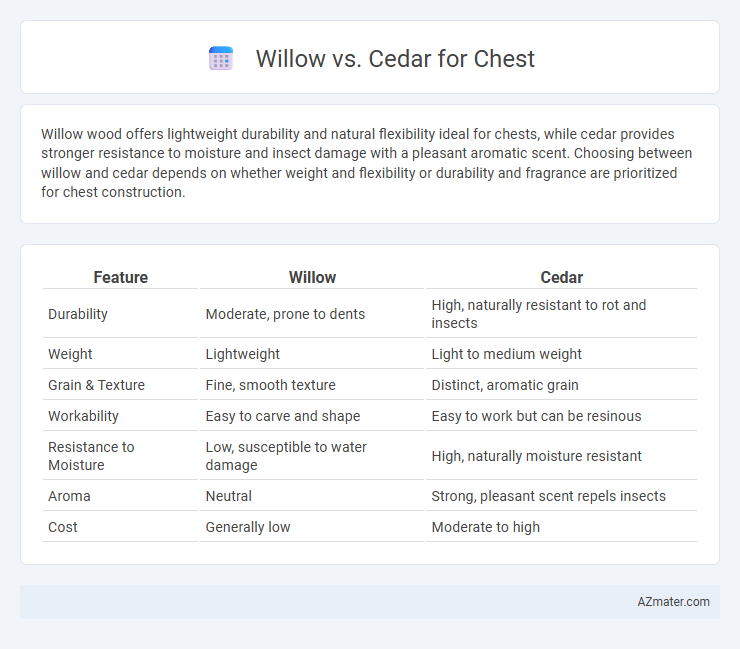Willow wood offers lightweight durability and natural flexibility ideal for chests, while cedar provides stronger resistance to moisture and insect damage with a pleasant aromatic scent. Choosing between willow and cedar depends on whether weight and flexibility or durability and fragrance are prioritized for chest construction.
Table of Comparison
| Feature | Willow | Cedar |
|---|---|---|
| Durability | Moderate, prone to dents | High, naturally resistant to rot and insects |
| Weight | Lightweight | Light to medium weight |
| Grain & Texture | Fine, smooth texture | Distinct, aromatic grain |
| Workability | Easy to carve and shape | Easy to work but can be resinous |
| Resistance to Moisture | Low, susceptible to water damage | High, naturally moisture resistant |
| Aroma | Neutral | Strong, pleasant scent repels insects |
| Cost | Generally low | Moderate to high |
Introduction: Willow vs Cedar for Building Chests
Willow and cedar are popular wood choices for building chests due to their unique properties and aesthetic appeal. Willow offers flexibility and a lighter weight, making it suitable for intricate designs and easy handling. Cedar is renowned for its natural resistance to moisture and insects, providing durability and longevity for storage solutions.
Overview of Willow and Cedar Wood Properties
Willow wood is lightweight and flexible, making it ideal for applications needing shock absorption and moderate strength, while cedar wood is renowned for its natural resistance to decay, insect damage, and aromatic properties. Both woods have moderate hardness, but cedar tends to be more durable and stable in varying climates, providing longevity for outdoor or decorative chests. The distinct grain patterns of willow offer a softer, more uniform texture, whereas cedar exhibits a distinctive aromatic scent and reddish hue, adding both aesthetic and functional value.
Durability: Which Wood Lasts Longer?
Cedar wood is known for its natural resistance to decay, insect damage, and moisture, making it highly durable for chest construction and outdoor use. Willow wood, while lightweight and flexible, is less durable and more prone to warping and rot over time compared to cedar. For longevity and lasting structural integrity in chests, cedar is generally the superior choice.
Aroma and Scent: Cedar vs Willow Chest
Cedar chests emit a warm, rich aroma with earthy, woody notes that naturally repel insects and preserve stored items, enhancing the chest's functional appeal. Willow chests offer a subtle, fresh scent with light floral undertones, providing a gentle fragrance that is less intense but equally pleasant. The strong, aromatic woodiness of cedar contrasts with the mild, airy fragrance of willow, influencing the choice based on personal scent preference and storage needs.
Resistance to Pests and Decay
Willow wood exhibits moderate resistance to pests and decay but often requires proper treatment to enhance durability in chest construction. Cedar is naturally resistant to a wide range of insects and fungal decay, making it an ideal choice for long-lasting chest durability without extensive chemical treatments. Choosing cedar ensures better protection against moisture-related damage and wood-boring pests, extending the lifespan of chests in various environments.
Workability and Crafting Ease
Willow wood offers exceptional workability due to its lightweight and soft texture, making it ideal for intricate chest crafting and detailed carving. Cedar, while slightly harder, provides moderate ease of crafting with natural oils that reduce the risk of splitting and enhance durability in chest construction. Both woods respond well to hand tools and power tools but willow's smooth grain allows for faster cuts and a finer finish in chest projects.
Appearance and Grain Comparison
Willow wood displays a pale yellow to light brown color with a fine, straight grain that often appears uniform and smooth, making it ideal for a sleek chest design. Cedar, in contrast, features a rich reddish-brown hue with distinct, wavy or interlocked grain patterns that add character and depth to furniture pieces. The contrasting grain textures and color tones between willow and cedar provide unique aesthetic options for a chest, with willow offering subtle elegance and cedar delivering warm, rustic charm.
Cost and Availability: Willow vs Cedar
Willow is generally more affordable and widely available due to its faster growth rate and abundant supply, making it a cost-effective option for chest construction or furniture. Cedar tends to be pricier because of its slower growth, resistance to decay, and demand in premium woodworking projects. Availability of cedar can be more limited depending on the region, whereas willow is often found in various climates, enhancing its accessibility.
Best Uses: When to Choose Willow or Cedar
Choose willow for lightweight chest construction where flexibility and shock absorption are essential, such as sports equipment or rustic furniture. Opt for cedar when durability, natural resistance to insects, and a pleasant aroma are priorities, making it ideal for storage chests and outdoor use. Cedar's moisture-repellent properties also make it suitable for guarding delicate items, while willow excels in applications requiring easy shaping and flexibility.
Final Verdict: Which Wood is Better for Your Chest?
Willow offers a lightweight, flexible option with moderate durability, making it ideal for chests that require ease of movement and a natural, rustic appeal. Cedar excels in natural resistance to decay and insects, providing long-lasting protection and a rich aroma that deters pests, perfect for storage chests in humid or pest-prone environments. For a chest that prioritizes longevity and protection against elements, cedar is the superior choice, while willow suits lighter, more decorative uses.

Infographic: Willow vs Cedar for Chest
 azmater.com
azmater.com